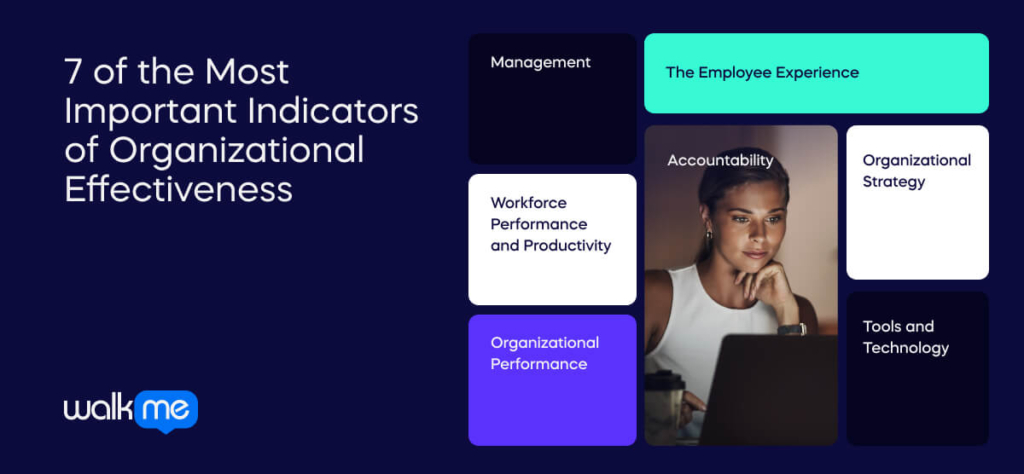Indicators of organizational effectiveness are vital to correctly measuring organizational performance, results, and efficiency.
Below, we will examine organizational effectiveness in more detail, including:
- Some of the most important indicators of organizational effectiveness
- How to define and model organizational effectiveness
- Tips for measuring and improving each metric
Before exploring specific indicators, we should establish a baseline definition of organizational effectiveness.
What Does Organizational Effectiveness Mean for Your Business?
Different models offer different perspectives on how to view organizational effectiveness.
These perspectives can be based on, for instance:
- How efficiently and effectively an organization meets its stated objectives
- The efficiency of business functions and processes
- How well an organization meets the needs of its stakeholders
- How effectively an organization can obtain and use resources
There are quite a few different models of organizational effectiveness.
Choosing the a model for organizational effectiveness will certainly impact how a business chooses to measure and make improvements.
However, despite these differences, the same indicators can offer insight into the efficiency and effectiveness of a business.
7 of the Most Important Indicators of Organizational Effectiveness

Here are some of the most important indicators to watch when evaluating organizational effectiveness:
1. Management
Management plays a large role in workforce performance, including:
- Workforce engagement
- Teamwork
- Employee productivity
- The organizational climate
According to Gallup, for instance, poor management is a major contributor to employee disengagement … which, in turn, lowers productivity, retention, and motivation.
2. Workforce Performance and Productivity
Employee performance directly affects their contribution to the efficiency and results of a business unit.
And the performance of each business unit, in turn, affects the organization’s overall performance.
Several factors can contribute to workforce performance, including:
- Management, as mentioned above
- The organization’s culture, values, and mission
- Tools and technology, as well as employees’ skills with those tools
- The work environment
- Employee engagement
Among others.
In short, employees play a vital role in how well a business performs and achieves its objectives.
3. Accountability
Accountability ensures that every task is assigned, delegated, and tracked.
Maintaining accountability ensures that:
- Everyone knows who is responsible for what
- Goals are met
- Rules, procedures, and processes are clearly defined
- People are rewarded or disciplined accordingly
Systems of accountability are essential to keeping employees on track, in sync, and productive.
4. The Employee Experience
The employee experience covers every aspect of a worker’s interaction with a company, from pre-hire communications to post-exit surveys.
The employee experience can include corporate communication, the physical work environment, collaboration with team members, equipment, and so forth.
Good employee experiences can positively affect:
- Morale
- Motivation
- Commitment
- Engagement
- Performance
Among other things.
Measuring employee sentiment can be accomplished through surveys, meetings, one-on-one discussions, and so forth.
5. Organizational Performance
One of the most useful indicators of organizational effectiveness is how well an organization meets its goals.
Measuring organizational performance can be accomplished by:
- Comparing actual achievements against set goals. Comparing the projected aims, such as profit and innovation, against actual results.
- Measuring the efficiency of business functions, areas, and processes. How cost-effectively, efficiently, and quickly business areas achieve their aims.
- Balancing expenditures against returns. Viewing each business project or process as an investment, and the results of that process as the return on that investment.
This is perhaps the most straightforward indicator of organizational effectiveness.
In this case, organizational effectiveness amounts to a cost-benefit analysis.
Organizations that meet or exceed their set aims would be considered more effective than those that don’t.
6. Organizational Strategy
Organizational strategy also contributes to the overall effectiveness of an organization.
The effectiveness of organizational strategies can be measured by how well they help a business:
- Stay competitive. Organizations must constantly be vigilant to stay ahead of their competitors. An appropriate business strategy can keep an organization from losing market share and customers.
- Meet the demands of its customers. Customers demands are constantly changing. An effective strategy helps businesses keep up with those demands, build their audience base, increase customer value, and maintain a positive brand image.
- Adapt to the changing needs of the marketplace. Today, organizational change is the norm. In today’s continually changing marketplace, businesses must stay agile, flexible, and adaptable. In other words, the strategy should also change to stay effective in a changing environment.
As mentioned above, some professionals measure organizational effectiveness by how well an organization achieves its goals.
However, setting the right goals is just as important as meeting those goals.
After all, the wrong strategy can be very detrimental – no matter how efficiently it meets its stated objectives.
7. Tools and Technology
In the digital age, digital capabilities are a prerequisite for success.
Without the right tools, an organization simply cannot keep up with its competitors.
The right tools and technology positively impact:
- Overall business productivity. Digital tools and platforms can add enormous value to every business area. They can improve employee productivity, enhance the efficiency of business processes, improve customer service, offer actionable intelligence, and much more.
- The workforce experience. A digitally-powered workplace also improves the employee experience. For instance, effective digital tools and training can improve worker efficiency, productivity, collaboration, engagement, and motivation, among other things.
- Organizational results. Ultimately, the right digital tools can improve organizational productivity. Good digital tools can help organizations meet their goals more effectively, efficiently, and quickly.
When businesses successfully adopt and implement digital tools, they can experience significant productivity gains across every business function.
In today’s digital ecosystem, digital technology is critical to an organization’s overall effectiveness.
Therefore, how well an organization adopts and utilizes those tools is another major indicator of organizational effectiveness.
Frequently Asked Questions
Digital dashboards provide real-time visibility into key performance indicators (KPIs), enabling organizations to monitor progress, identify trends, and make informed decisions promptly.
Balancing leading indicators (predictive measures) with lagging indicators (outcome-based measures) offers a comprehensive view of performance, allowing organizations to anticipate challenges and evaluate results effectively.
Organizations should reassess their effectiveness indicators during significant changes such as strategic shifts, market dynamics alterations, or after implementing new technologies to ensure alignment with current objectives.
Incorporating non-financial metrics like employee engagement, customer satisfaction, and innovation rates provides a more holistic assessment of organizational effectiveness beyond traditional financial measures.

